
New Mexico Geological Society
Special Publication - 10
Environmental Geology and Hydrology in New Mexico

S. G. Wells, W. Lambert and Jonathan F. Callender, eds, 1981, 152 pages.
New Mexico encompasses four physiographic provinces with diverse geologic, hydrologic, and vegetative characteristics: rolling grassland plains, elongate desert basins, high semiarid plateaus, and towering forested mountains. Much of this land occurs within zones of transition from one landscape or climatic type to another, creating an especially fragile natural environment. New Mexico is a state with abundant and rich energy and mineral resources including oil, gas, coal, uranium, copper, molybdenum, gypsum, and sand and gravel as well as geothermal, solar, and wind resources. Add to this setting a variety of people with different industrial and agricultural endeavors, cultural backgrounds, and political pursuits, and it is easy to see that New Mexico is a state with an ample share of environmental geologic and hydrologic concerns.
The interactions of humans with the geologic and hydrologic environment has been a fact of life since humans first set foot in what is now New Mexico. These interactions range from the attempt of Indians to halt the fall of Threatening Rock in Chaco Canyon several hundred years ago to the recent attempts of scientists to evaluate the suitability of bedded salt in southeastern New Mexico for the long-term disposal of radioactive wastes. As noted by Hawley and Love in this volume, the hallmark of environmental geology and hydrology is the gathering and presenting of scientific information to the public. The application of geology and hydrology as a means of maximizing advantageous use of the natural environment and minimizing adverse environmental changes requires a scientifically sound data base. W. C. Mendenhall, fifth Director of the U.S. Geological Survey, stated simply "There can be no applied science unless there is science to apply." In order to maintain a proper stewardship of our geologic and hydrologic resources, we must continue in our endeavors to acquire, analyze, and communicate scientific information.
This volume, which includes both regional overviews and detailed case studies, has been prepared for the meeting of the Rocky Mountain Section of the American Association of Petroleum Geologists in Albuquerque, April 13-15, 1981. The theme of this meeting is energy diversity, and in accordance with this theme, a majority of the articles in this volume reflect the diverse environmental concerns associated with energy-resource development in New Mexico. In addition, the volume contains articles dealing with the environmental geologic and hydrologic aspects of hazardous-waste disposal and watershed management. The articles have been contributed by scientists in private industries, consulting firms, universities, national laboratories, and State and Federal agencies. This diversity of contributors and affiliations indicates the broad spectrum of talents and interests that are currently being applied in the search for solutions to the complex environmental geologic and hydrologic problems facing the citizens of New Mexico.
Softcover:
$4.50
Buy
Now
Contents
Front Matter (Location Map, Table of Contents, Forward ; 1.77MB PDF)
Overviews of Environmental Geology and Hydrology in New Mexico
Overview of Geology as Related to Environmental Concerns in New Mexico
— John W. Hawley and David W. Love, pp. 1-10.
An Overview of Hydrology and Environmental Concerns in New Mexico
— John S. McLean, pp. 11-14.
Overview of Energy Resources in New Mexico
— P. R. (Bob) Grant, Jr., pp. 15-20.
Human Interactions with the Hydrologic Environment
Preliminary Analysis of Historical Streamflow and Water-Quality Records for the San Juan River Basin, New Mexico and Colorado
— Carole L. Goetz, pp. 21-26.
Geomorphic Response of the Rio Grande to Dam Construction
— Peter F. Lagasse, pp. 27-46.
Potential for Ground-Water Pollution in New Mexico
— Lee Wilson, pp. 47-54.
Energy-Mineral Development and the Geologic/Hydrologic Environment
Hydrology of Strippable Coal Deposits in the San Juan Basin
— T. E. Kelly, pp. 55-62.
Effects of Mining and Reclamation on Hydrologic Parameters, West-Central New Mexico
— Brant A. Dennis and T. E. Kelly, pp. 63-68.
Applications of Geomorphology to Surface Coal-Mining Reclamation, Northwestern New Mexico
— Stephen G. Wells and Devon E. Rose, p. 69-84.
Water-Quality Aspects of Uranium Mining and Milling in New Mexico
— Bruce M. Gallaher and Maxine S. Goad, pp. 85-92.
Hazardous-Waste Disposal and the Geologic/Hydrologic Environment
Geologic, Geochemical, and Hydrological Criteria for Disposal of Hazardous Wastes in New Mexico
— Patrick A. Longmire, Bruce M. Gallaher, and John W. Hawley, pp. 93-102.
Fluid-Waste Movement through the Vadose Zone
— Daniel B. Stephens and Joel Siegel, pp. 103-110.
Progress in Modeling Natural Fracture Distribution in Sedimentary Rocks
— John F. Gibbons, Charles F. Ferral, and Caroline H. Persson-Reeves, pp. 111-118.
Geologic Investigations of the WIPP Site: Overview and Issues
— Dennis W. Powers, pp. 119-122.
Geohydrology of the Proposed Waste Isolation Pilot Plant Site in Southeastern New Mexico
— Jerry W. Mercer and Don. D. Gonzalez, pp. 123-132.
Deep-Seated Salt Dissolution in the Delaware Basin, Texas and New Mexico
— Roger Y. Anderson, pp. 133-146.
Geochronologic Studies Near the WIPP Site, Southeastern, New Mexico
— Douglas G. Brookins, pp. 147-152.



